
Other disorders can deal with a variety of different ways to pronounce consonants. However, the two can coexist, affecting the same person. This makes them different from specific language impairment, which is primarily a disorder of the syntax (grammar) and usage of language rather than the sound system. Though phonemic disorders are often considered language disorders in that it is the language system that is affected, they are also speech sound disorders in that the errors relate to use of phonemes. This is called the fis phenomenon based on a scenario in which a speech pathologist will say, "Did you say 'fis,' don't you mean 'fish'?" To which the child responds, "No, I didn't say 'fis,' I said 'fis'." In some cases, the sounds produced by the child are actually acoustically different, but not sufficiently so for others to distinguish – because those sounds are not phonemically unique to speakers of the language. Some children with phonemic disorders may seem to be able to hear phoneme distinctions in the speech of others but not their own. Phonemic disorders are often treated using minimal pairs (two words that differ by only one sound) to draw the child's attention to the difference and its effect on communication. As a result, the number of error sounds is often (though not always) greater than with articulation disorders and substitutions are usually the most common error. For example, the sounds /k/ and /t/ may not be recognized as having different meanings, so "call" and "tall" might be treated as homophones, both being pronounced as "tall." This is called phoneme collapse, and in some cases many sounds may all be represented by one - e.g., /d/ might replace /t/, /k/, and /g/. In a phonemic disorder (also called a phonological disorder) the child is having trouble learning the sound system of the language, failing to recognize which sound-contrasts also contrast meaning.
#SOUNDSOURCE HOW TO#
They are often treated by teaching the child how to physically produce the sound and having them practice its production until it (hopefully) becomes natural. There are usually fewer errors than with a phonemic disorder, and distortions are more likely (though any omissions, additions, and substitutions may also be present). If the disorder has anything to do with any of these articulators, then it is an articulation disorder. Articulation disorders have to do with the main articulators which are the lips, teeth, alveolar ridge, hard palate, velum, glottis, and the tongue. Though speech sound disorders are associated with childhood, some residual errors may persist into adulthood.Īrticulation disorders (also called phonetic disorders, or simply "artic disorders" for short) are based on difficulty learning to physically produce the intended phonemes. However, some may have a mixed disorder in which both articulation and phonological problems exist.

Speech sound disorders may be subdivided into two primary types, articulation disorders (also called phonetic disorders) and phonemic disorders (also called phonological disorders).


 0 kommentar(er)
0 kommentar(er)
